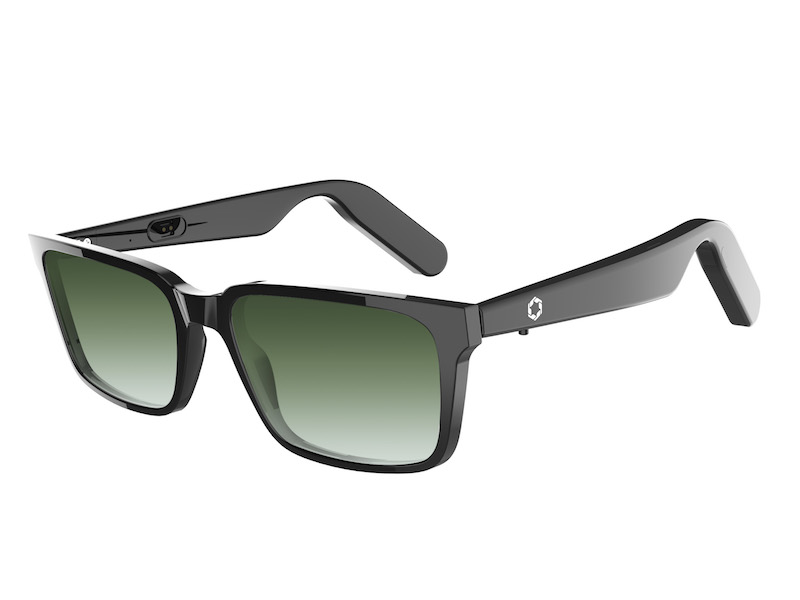A number of companies have tried, and failed, to make smart glasses. The most notable was Google with their widely publicized Google Glass. I believe the downfall of these attempts at smart glasses has been a desire to incorporate as much technology as possible into the product, including video capture, a user interface in the glass, and more. In addition to the technical challenges brought on by incorporating all this technology into a set of glasses, the video capture capabilities of the glasses opened up a host of privacy issues.
On the other hand, a simpler design that could potentially be leveraged to control a smart home was very interesting to me. With that in mind, I accepted an offer to try a pair of Lucyd Lyte glasses.
Lucyd doesn’t call their glasses smart. They simply label them “Bluetooth Audio Glasses.” This is an apt description, but their capabilities go beyond that description.
The glasses come as optical glasses or sunglasses with 15 different frame styles. Lenses can be ordered with prescriptions (Single Vision Rx, Progressive Rx, or Readers). They can also be ordered as blue light blockers (filters 20% – 40% of blue light for use with computers); transitions (changes from clear to dark with exposure to sunlight, and there is also an option for transitions that work inside an automobile); sunglasses in various lens colors; and a host of other options.

Extra lenses can be ordered so you can, for example, change your blue light blocking computer glasses to sunglasses without the need to purchase a second frame.
The Lucyd Lyte glasses offer everything you would expect from a personal Bluetooth audio product:
- The ability to play music through four speakers located in the arms of the glasses
- The ability to take calls using two noise cancelling microphones
- Touch controls to play/pause music, adjust the volume, answer/hang-up a call, and skip tracks
- 12-hour battery life with 2-hour charge time
- An iPhone app (Android is coming)
What differentiates Lucyd Lyte glasses from a basic Bluetooth speaker product is the ability to use Siri or Google Voice (depending on your phone platform). They also offer the ability, through the Lucyd app, to make ChatGPt hands free and voice accessible. And, with some technical additions to a smart home processor/hub, they can perform smart home actions via voice commands.
Hands on with Lucyd Lyte Glasses
Lucyd offered me a generous discount on the glasses I used for this article. However, with the inclusion of progressive prescription lenses and transitions that worked behind a car windshield, that discount only covered part of the cost of the glasses.
In the box were the Lucyd Lyte glasses, a fold-flat storage case for the glasses, a cleaning cloth, USB charger and magnetic cables that attach to each arm of the glasses for charging, a soft slip case for the glasses to protect the lenses from scratching, and a quick start guide.
The quick start guide included all the information you need to get started using the Lucyd Lyte glasses.Overall, I found the functionality offered by the Lucyd Lyte glasses to be a quite useful. Audio quality of the open-air speaker system in the arms of the glasses is adequate but certainly not audiophile quality. There was a lack of bass making It was much more suited to phone calls or podcasts than for listening to music.
The open-air speakers do allow the glasses to be used while driving because they don’t — like ear buds — block sounds from around the user. However, it is important to note that people around you can definitely hear the sound from the open-air speaker system. So, don’t expect privacy during a phone call. I think a bone conduction system for sound would be real an improvement for the next generation of the Lucyd glasses at it would offer improved sound quality and privacy.
The design of the glasses is unobtrusive. Other people will probably not be aware that you are wearing smart glasses. In addition, you won’t be viewed as one of “those people” walking around with bright white AirPods sticking out of your ears
The Lucyd Lyte glasses offer a wide range of functionality and convenience. They succeed because they offer functionality that people will use and don’t delve into the realm of science fiction.
One thing to know is that there is a learning curve for new users. The buttons on the arms of the glasses are used in many ways. Different actions are trigged by single tapping, pressing and holding, double tapping, and even triple tapping of the buttons. For example, a single tap while playing music raises or lowers the volume depending on which button was pressed, a double tap answers a call or hangs up a call, a double tap while playing music performs play/pause, a triple tap while playing music performs a next/previous track jump depending on which button was pressed, and much more.
Leveraging the Voice Assistant
Pressing and holding either of the buttons on the glasses for two seconds enables Siri or Google Voice (depending on your phone platform. While Siri, on my iPhone, is not my voice assistant of choice, it is very useful in this context due to its tight integration with the functionality of my phone. For example, you can place calls, listen to voicemails, return a missed call, read and reply to text messages, send an email, ask for directions, play music, set an alarm, and set a timer.
This makes the Lucyd Lyte glasses a very useful hands-free accessory for a smart phone.
Lycid also offers voice access to ChatGPT. This requires the Lucyd app be installed on your phone. Currently the Lucyd app is only available for the iPhone but an Android version has been promised. There is a YouTube video that walks a user through the procedure for making this work. That video can be found here. Once you have followed all the instructions, you simply activate ChatGPT by pressing and holding either button on the glasses until you hear a beep, say “use lucid” to trigger a shortcut that activates the Lucyd app and allows your query to be sent to ChatGPT, and the ChatGPT response will be both annunciated to you through the speakers on the glasses and displayed as text in the app.
Smart Home Integration
If my smart home was based on Apple’s smart home technology, then control of my smart home through Siri would be baked into the product. However, my smart home is based on the integration of a wide range of different technologies so controlling my home using the Lucyd Lyte glasses becomes a much more challenging problem.
I should mention that as the adoption of the Matter protocol by different smart home product manufacturers grows, this problem will go away, or at least be diminished. Apple already provides for the integration of Matter-compatible products into its ecosystem so those products could directly be controlled by Siri. Unfortunately, the adoption of the Matter protocol, is moving forward at a slow pace leaving me having to craft a unique solution to make this happen today
What I did was to leverage code I wrote to integrate tapping NFC tags with an iPhone to trigger actions on my Crestron smart home processor using the Apple Shortcuts app (an article describing that can be found here). I simply speak the shortcut name to trigger it and it then makes an http call to my Crestron processor. The same code that receives an http trigger when an NFC tag is tapped, receives the http request, and triggers a smart home action. This same strategy can be incorporated into other smart home platforms.
I need to mention that without leveraging port forwards on my router (which would be a significant security issue and an invitation to hackers to infiltrate my network), this only works when my iPhone is connected by Wi-Fi to my home’s Wi-Fi network. However, that is where the majority of smart home actions take place and, in my case, I can issue voice commands, using the Alexa app, when I need to remotely control my smart home (though not through the Lucyd Lyte glasses).
Overall, the Lucyd Lyte glasses offer some really nice features and a great deal of hands-free convenience to a phone. They are unobtrusive and most people around you won’t even realize you are wearing “smart glasses”. The ability to make verbal queries to ChatGPT is also useful as is the ability to control a smart home.
If your smart home isn’t based on Apple technologies, until the Matter protocol becomes more universally adopted, smart home control requires some technical skills to implement. I leveraged code the I wrote to trigger smart home actions with NFC tags through Apple Shortcuts to make this work in my own home.
On the downside, direct bone conduction would offer improved audio quality and privacy compared to the small speakers in the glasses. A second downside is that it will take a new user some time to come up to speed on the operation of the buttons used for control of the glasses because of the multitude of functions that have been incorporated into them through tapping, pressing and holding, double tapping, and even triple tapping.








